This week I want to tell you about the Reverend Michael Adler (1869-1944), a rather remarkable man and his role in the often over-looked history of British Jewish Chaplains during the First World War. This was the first time in Anglo-Jewish history that Jewish Chaplains formed part of the British Army on active service.
Jews were only recognised in the British army as a distinct religious body from 1889. The Visitation Committee of the United Synagogue were responsible for the religious welfare of and spiritual needs to Jews in public institutions. It decided to extend the scope of its activities to serving members of the British Forces and applied to the War Office for the appointment of a Jewish Chaplain. This request was granted in 1892 and Rabbi Francis L. Cohen was appointed as the first Jewish Chaplain. In 1904 he was succeeded by Rev. Adler.
According to Captain Henry Myer, Adler was “a most unmilitary looking man with a neat auburn beard and a rather corpulent figure”. He writes that he was placid and many members of his Company came to tell him their favourable impressions of Adler.
Prior to the First World War there were 1000 Jews in the British Forces and Adler was the Minister of a large congregation for the Central Synagogue in London. He held a commission as Territorial Chaplain from August 1914 until January 1915 and was in charge of religious work in the UK and corresponded with Jewish soldiers at the front. However, Adler soon realised his services could be used to even better effect in France, he writes;
“My work at home as a Territorial Chaplain soon proved to me that opportunities for valuable service in the war area would present themselves, if the necessary arrangements for proceeding abroad could be made”.
In January 1915 Adler went to France to assess the need of a Jewish Chaplain at the front. He proposed to the War Office that he wear the Magen David (Star of David) instead of the Chaplain’s badge to make him easier to identify. After he returned to London, he presented a report to the War Office on his findings which showed a desperate need for a Jewish Chaplain at the front and was sent back to France.
Adler took up various quarters along the front line and obtained an official return of all the Jews in each division. He received information of the location of each unit from the Divisional HQs and visited the units individually in a motor car provided for him. In some areas the divisions were close to each other and he could organise services for larger groups. For others he travelled after sending telegrams to assemble the Jewish soldiers together.
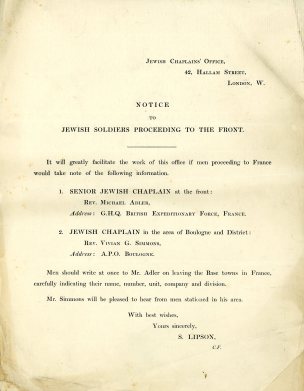
A notice sent to Soldiers proceeding to the Front. It tells them to let Adler know of their arrival to France. Adler writes that Jewish soldiers seemed to appreciate his work among them in a manner which more than compensates for any efforts.
“I would visit a group of men…in some out-of-the-way place, much to their gratification, and a friendly chat and smoke always concluded with a brief religious service, in which the men earnestly joined.”
An original draft of a notice that would be printed and sent to the soldiers. It asks them to write to Adler if they wish. The note at the top asks for 200 copies to be printed. These notices were published in Base Orders, posted in Y.M.C.A huts and invitations sent to all officers and men.
Adler conducted services every Sunday and frequently during the week where the attendance varied from 20-150.
A photograph of an outdoor service for the Jewish Battalion in Ludd Palestine, 1918. It is thought that this could be Rev Michael Adler conducting the service.
Services were held in all sorts of places, often in the open-air and in Y.M.C.A or Church Army huts as well as barns or ruined buildings.
“On one occasion during the Somme battles of 1916, when visiting a R.A.F balloon unit… the C.O ordered us to shelter in an old German dug-out as it was not safe where we were standing”.
He held services in villages several miles from the trenches and men frequently came direct from the firing line. These services were so important to the Jewish soldiers that they would travel miles to attend.
“40 men received passes to come straight back from the fighting and join me at a service about three miles away”.
Adler also held services before large battles, such as a Yom Kippur service in Noeuz-les-Mines in 1915, one week before the Battle of Loos,
“Men marched in fully-equipped straight from the lines, special orders having been issued to set them free, and we numbered about 200… Many of the officers and men who were present at the service fell in action on the following Saturday when the Army “went over the top”.
Adler tried his best to persuade the Army Authorities to allow Jewish soldiers time off over Jewish holidays. This draft notice shows a request to give furlough for the Day of Atonement.
The form of Adler’s service was based upon the Soldier’s Prayer Book which he compiled and distributed, “a work which was very greatly treasured by the men.” Over 100,000 copies of the prayer book were printed and used by the army all over the world; it also served as a model for the American Military prayer book.
Adler kept a register of casualties and sent details of the deaths of Jewish soldiers. The Graves Registration Commission erected Jewish memorials over graves and sent Adler photographs to send to their relatives. He conducted funerals and would travel long distances to do so, he also visited wounded soldiers in hospitals.
This is a letter that Adler sent to the wife of Lewis Nathan after he visited him in hospital. He writes “I saw your husband today in one of the local hospitals. He has been wounded but is now making excellent progress…” Although he travelled to carry out many funeral services due to the large number of deaths and huge miles to travel Adler was only able to conduct one burial in every 20.
Another duty that fell to Adler was to write to the soldiers and their families. As soon as Adler heard that a soldier had crossed the channel he sent a notice such as the ones below.
Correspondence to the men and their families was substantial and he received up to 30 letters a day.
“My heavy post-bag at times was the standing joke of the local Army Post Office and of my Mess, and many hours were spent at the desk in keeping in touch by letter, both with the soldiers and their anxious relatives. The address “Jewish Chaplain, France”, was sufficient to find me”.
Adler corresponded and met with Lt Marcus Segal during his time in France. On 27th Nov 1916 he wrote
“Dear Mr Segal,
Thanks for your information about young Davidson – which answers all I wished to know. I am in your area and hope to see you soon – if your Bn is still with the 3rd Division I know exactly where you are and I am a few miles off. “
Marcus told his parents of his meetings with Adler.
“Yesterday the 22nd inst., Adler came to see me and we are arranging for a Service on the 26th inst., and are going to get as many Yiddish boys as possible. He was very pleased to see me and took a great interest in me.”
It is really fascinating to have the stories of both men in our collection and that they knew each other personally!
It became very clear to Adler that there were not enough Jewish Chaplains on the Front line and he claimed that Jewish soldiers often did not see a Chaplain for months, unlike Christian soldiers, who once a week attended a church parade. He slowly persuaded the authorities to provide additional Chaplains, and as the area occupied by the British Army abroad increased so did the number of Chaplains; by the end of the war there was a Chaplain attached to each of the five Army areas and three at the Bases.
Adler left France in July 1918 due to poor health but left a lasting legacy. He edited the British Jewry Book of Honour which was published in 1922. It permanently records and honours the contribution made by the 50,000 Jews who served in the British and colonial forces during World War I.
It describes Jewish enlistment, casualties, military honours, Jewish Units and the work of Jewish hospitals and other Jewish institutions and agencies. Importantly, it contains alphabetical lists of those killed in action, those who were awarded military honours and the nominal rolls of Jews who served, listed by service and by regiment.

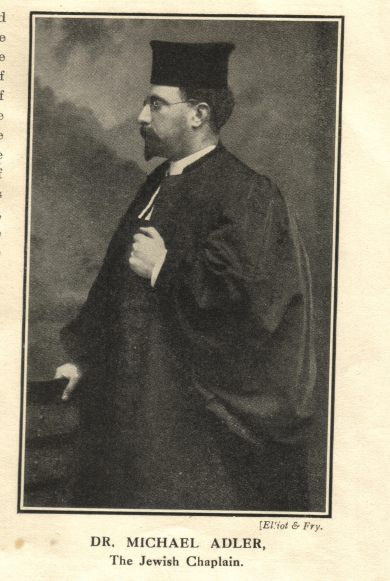
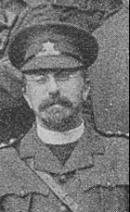
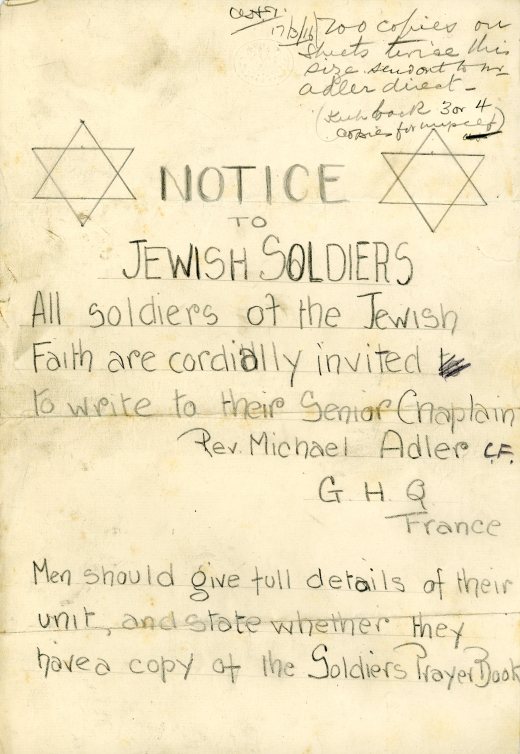
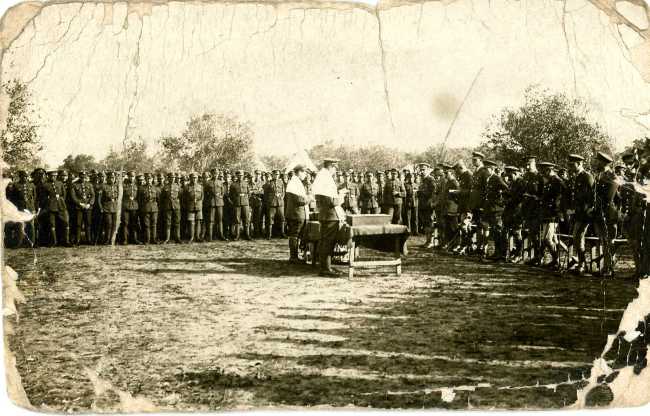
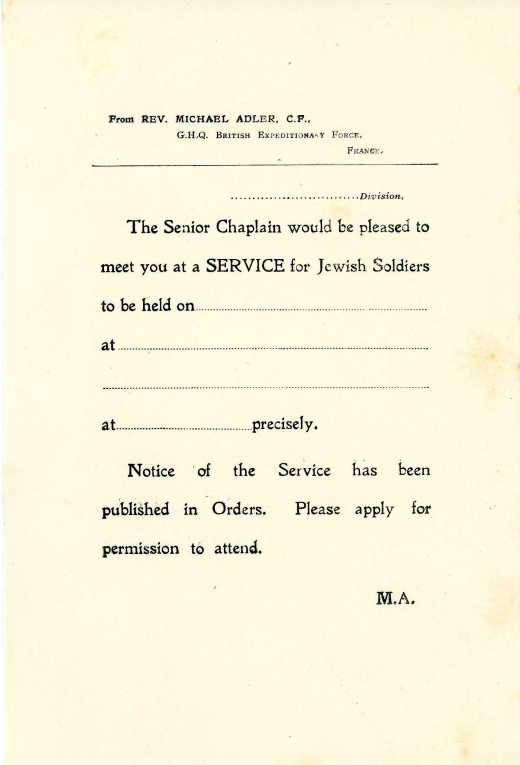
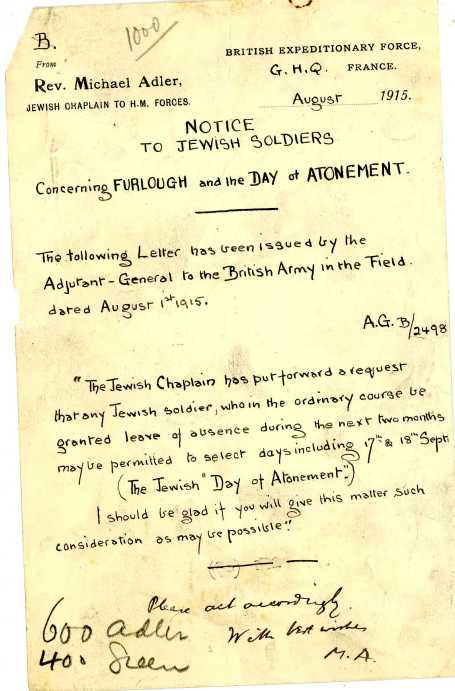
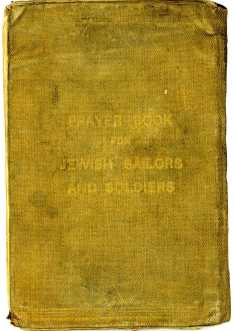
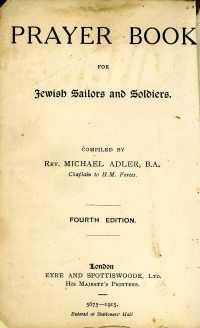
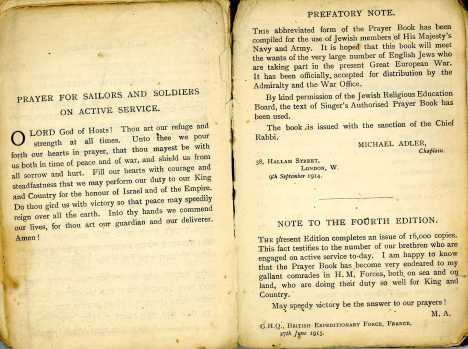
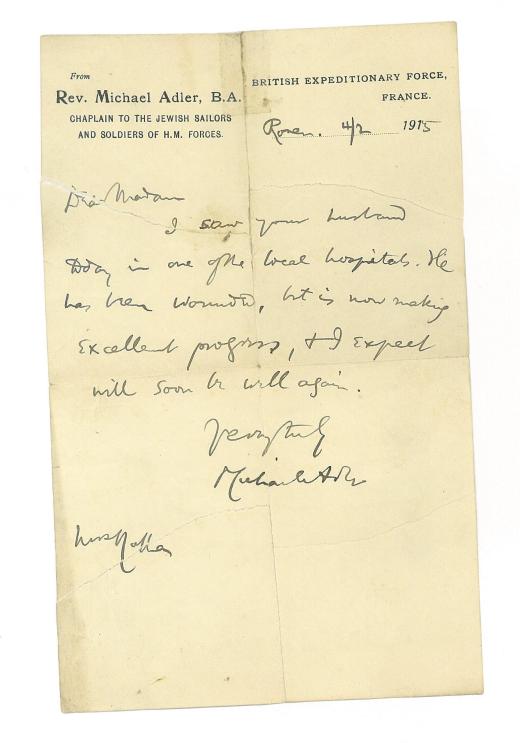
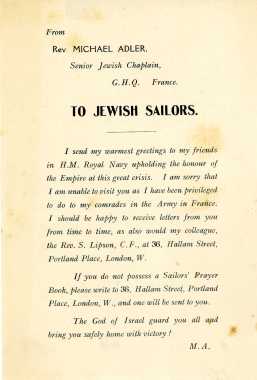
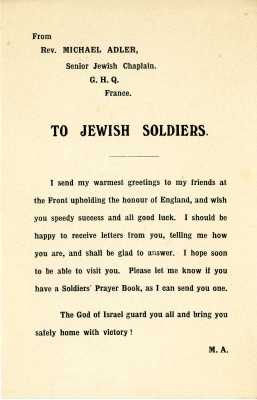
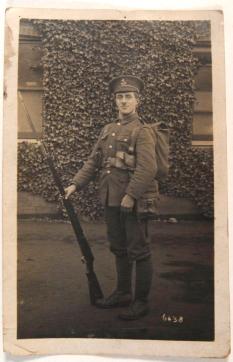
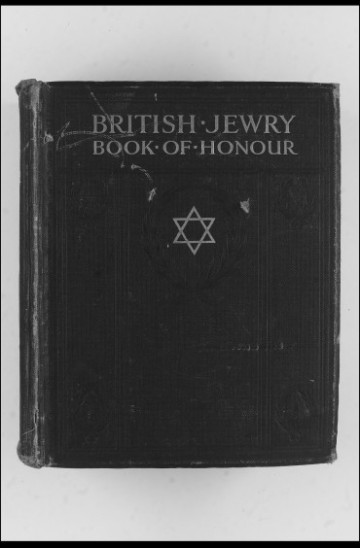
You may be aware of my book ‘Muddling Through: the Organisation of British Army Chaplaincy in World War One’, published by Helion in April 2013. There are a number of references to the Jewish contribution, including Michael Adler’s Commission in the Territorial Force before 1914. I find the material here fascinating. Peter Appelbaum has just published a book on Jewish Chaplains in the Kaiser’s army ans that too is of great interest.
With good wishes
Rev Dr Peter Howson
Thank you for your message Peter, I wasn’t aware of your book so I will have to find a copy! I met Peter Applebaum at the Jewish Museum last week where he talked about his book and gave our museum a copy, he had really fascinating things to say. Best wishes, Sarah
The book is available through Amazon, or direct from the publishers Helion and Company. The ISBN is 978-1-909384-20-0. If you have a problem then I have some and would be happy to deliver one. Although the emphasis at present is on World War One the contribution of Jewish chaplains to the British forces in World War Two was perhaps even more interesting. There is also an excellent book, ‘Rekindling the Flame: American Jewish Chaplains and the Survivors of European Jewry 1944 – 1948’ by Alex Grobman. It has litle on the British involvement but makes interesting reading.
Peter
Missing words possibly LIMBURG, McIvey Cheese, Puppchen (Dolls) Arnold Cookman, Lovely?, 82 Com Oly (not sure0 gripping parcel
[…] I’d write about the British Jewry Book of Honour. I have mentioned this in some of my previous blog posts but today I want to tell you more about […]